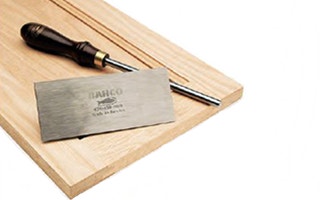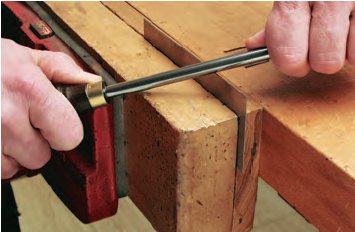How to Sharpen and Burnish a Cabinet Scraper in Three Steps

Q: I’m trying to smooth a piece of cherry knot or crotch wood I’ve had drying out for about three years now. I resawed a slice with my band saw, but when I turned to my cabinet scrapers they were very dull. I tried to sharpen them but had little luck getting the wire edge on them that makes them work so well. I have a good quality burnishing rod I purchased at a cabinet shop, but I’m afraid I don’t know the proper method of using it. Would you please explain the proper process of sharpening and burnishing a cabinet scraper? My band saw resaws very well, but this wood is hard as a rock and needs a good scraping. Burnisher and cabinet scraper To properly use cabinet scrapers, they need to be razor sharp, but getting that fine edge requires proper use of a burnisher.
A: Like putting an edge on the other cutting tools you have in your shop, burnishing a scraper is metalworking, not woodworking … so don’t feel bad if you need a couple of pointers. The goal of this task is to roll a small bit of metal from both outside edges of the scraper to create two sharp hooks (Note: this metal is malleable, not brittle).
Step One: Prepare the narrow edge. If you are resharpening a scraper, use your burnisher to flatten the existing remnant of the hook edge. (The first time you sharpen a scraper, this is not necessary.) Simply lay the scraper flat on a hardwood surface and slide the burnisher back and forth, flat against the face of the scraper. Push down hard as you do this. (This action is called burnishing!)
Step Two: Prepare a consistent rectilinear edge on the scraper blade. To roll the edge over, it needs to be square before you start. Often that means filing a clean “top” edge. You just need to remove a tiny bit of metal. Don’t go crazy here. To finish burnishing your scraper, set it up in a vise and scrape the edge back and forth with the burnisher.

Step Three: Roll each hook. Clamp the prepared scraper between two pieces of wood or in a padded bench vise. The long edge of the scraper should stand proud about 3/8". I hold the burnisher with two hands and position it at about 20° to the face of the scraper. Then I slide the burnisher back and forth (yup, burnishing), pushing down hard on the edge. I alternate “left and right” using the same two-handed technique and a reciprocal angle, to form cutting hooks on both sides of the scraper. About five passes (max) for each hook edge is all it really takes.
Interim Touchups: You don’t always need to file the edge clean and square. You can go back to step three and touch up your edge a couple of times before you go all the way back to step one.
Keep the inspiration coming!
Subscribe to our newsletter for more woodworking tips and tricks


